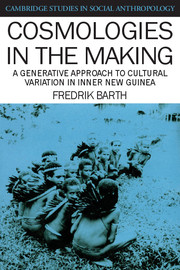Book contents
- Frontmatter
- Contents
- Foreword by Jack Goody
- Map: Major territories of the mountain Ok
- 1 The problem
- 2 An attempt at systematic comparison: descent and ideas of conception
- 3 The possible interrelations of sub-traditions: reading sequence from distribution
- 4 The context for events of change
- 5 The results of process – variations in connotation
- 6 Secret thoughts and shared understandings
- 7 The stepwise articulation of a vision
- 8 Experience and concept formation
- 9 The insights pursued by Ok thinkers
- 10 General and comparative perspectives
- 11 Some reflections on theory and method
- Bibliography
- Index
- Cambridge Studies in Social Anthropology
7 - The stepwise articulation of a vision
Published online by Cambridge University Press: 05 June 2012
- Frontmatter
- Contents
- Foreword by Jack Goody
- Map: Major territories of the mountain Ok
- 1 The problem
- 2 An attempt at systematic comparison: descent and ideas of conception
- 3 The possible interrelations of sub-traditions: reading sequence from distribution
- 4 The context for events of change
- 5 The results of process – variations in connotation
- 6 Secret thoughts and shared understandings
- 7 The stepwise articulation of a vision
- 8 Experience and concept formation
- 9 The insights pursued by Ok thinkers
- 10 General and comparative perspectives
- 11 Some reflections on theory and method
- Bibliography
- Index
- Cambridge Studies in Social Anthropology
Summary
The third kind of sequence of change which I claim is induced through oscillations of subjectification and objectification is perhaps most readily credible to an academic audience: that whereby the bearers of a sub-tradition pursue and develop a logical train of thought to further and new implications. Without any awareness of innovatively changing a received tradition, but merely by trying to communicate it more truly and deeply, such elaboration is profoundly stimulated by an organization where the ritual leader is required to ‘show’ the secrets of the cult to regularly recurring sets of new novices every ten years or so.
In trying to align and present the material to illustrate this process of generalization and abstraction, however, I am in danger of performing the abstraction myself, rather than revealing and pointing to its empirical occurrence in the tradition of knowledge I am describing. Likewise, the differences between the accounts from Tifalmin, Telefolmin, Bimin-Kuskusmin etc., may reflect differences in how far their ethnographers have gone in abstraction, and the emphases they have given, rather than empirical differences between the sub-traditions. Firth has perceptively warned us against adding our ‘personal dimension to the interpretation of an alien religious ideology, to raise the generalizations to a higher power than the empirical content of material warrants’ (Firth 1959: 139). To my knowledge, we have no methodology – other than perpetual vigilance and self-criticism – to help us avoid this, while much structuralist methodology entices and seduces us to the opposite.
- Type
- Chapter
- Information
- Cosmologies in the MakingA Generative Approach to Cultural Variation in Inner New Guinea, pp. 46 - 54Publisher: Cambridge University PressPrint publication year: 1987



